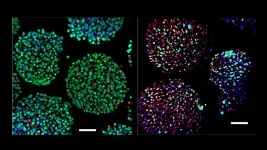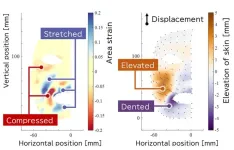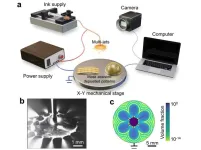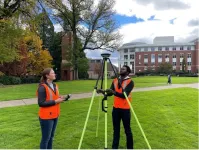(Press-News.org) Leveraging artificial intelligence and the largest pediatric brain MRI dataset to date, researchers have now developed a growth chart for tracking muscle mass in growing children. The new study led by investigators from Brigham and Women’s Hospital, a founding member of the Mass General Brigham healthcare system, found that their artificial intelligence-based tool is the first to offer a standardized, accurate, and reliable way to assess and track indicators of muscle mass on routine MRI. Their results were published today in Nature Communications.
“Pediatric cancer patients often struggle with low muscle mass, but there is no standard way to measure this. We were motivated to use artificial intelligence to measure temporalis muscle thickness and create a standardized reference,” said senior author Ben Kann, MD, a radiation oncologist in the Brigham’s Department of Radiation Oncology and Mass General Brigham's Artificial Intelligence in Medicine Program. “Our methodology produced a growth chart that we can use to track muscle thickness within developing children quickly and in real-time. Through this, we can determine whether they are growing within an ideal range.”
Lean muscle mass in humans has been linked to quality of life, daily functional status, and is an indicator of overall health and longevity. Individuals with conditions such as sarcopenia or low lean muscle mass are at risk of dying earlier, or otherwise being prone to various diseases that can affect their quality of life. Historically, there has not been a widespread or practical way to track lean muscle mass, with body mass index (BMI) serving as a default form of measurement. The weakness in using BMI is that while it considers weight, it does not indicate how much of that weight is muscle. For decades, scientists have known that the thickness of the temporalis muscle outside the skull is associated with lean muscle mass in the body. However, the thickness of this muscle has been difficult to measure in real-time in the clinic and there was no way to diagnose normal from abnormal thickness. Traditional methods have typically involved manual measurements, but these practices are time consuming and are not standardized.
To address this, the research team applied their deep learning pipeline to MRI scans of patients with pediatric brain tumors treated at Boston Children’s Hospital/Dana-Farber Cancer Institute in collaboration with Boston Children’s Radiology Department. The team analyzed 23,852 normal healthy brain MRIs from individuals aged 4 through 35 to calculate temporalis muscle thickness (iTMT) and develop normal-reference growth charts for the muscle. MRI results were aggregated to create sex-specific iTMT normal growth charts with percentiles and ranges. They found that iTMT is accurate for a wide range of patients and is comparable to the analysis of trained human experts.
“The idea is that these growth charts can be used to determine if a patient’s muscle mass is within a normal range, in a similar way that height and weight growth charts are typically used in the doctor’s office,” said Kann.
In essence, the new method could be used to assess patients who are already receiving routine brain MRIs that track medical conditions such as pediatric cancers and neurodegenerative diseases. The team hopes that the ability to monitor the temporalis muscle instantly and quantitatively will enable clinicians to quickly intervene for patients who demonstrate signs of muscle loss, and thus prevent the negative effects of sarcopenia and low muscle mass.
One of the limitations lies in the algorithms reliance on scan quality, and how a suboptimal resolution can affect measurements and the interpretation of results. Another drawback is the limited amount of MRI datasets available outside of the United States and Europe that can give an accurate global picture.
“In the future, we may want to explore if the utility of iTMT will be high enough to justify getting MRIs on a regular basis for more patients,” said Kann. “We plan to improve model performance by training it on more challenging and variable cases. Future applications of iTMT could allow us to track and predict morbidity, as well as reveal critical physiologic states in patients that require intervention.”
Authorship: Brigham-affiliated authors include Anna Zapaishchykova, Kevin X. Liu, Anurag Saraf, Zezhong Ye, Yashwanth Ravipati, Arnav Jain, Julia Huang, Hasaan Hayat, Jirapat Likitlersuang, Sridhar Vajapeyam, Rishi B. Chopra, Raymond H. Mak, Tabitha M. Cooney, Daphne A. Haas-Kogan, Tina Y. Poussaint, and Hugo J.W.L. Aerts. Additional authors include Paul Catalano, Viviana Benitez, Ariana M. Familiar, Ali Nabavidazeh, Adam C. Resnick, Sabine Mueller,
Disclosures: The other authors declare no conflict of interest.
Funding: The authors acknowledge financial support from NIH (HA: NIH-USA U24CA194354, NIH-USA U01CA190234, NIH-USA U01CA209414, and NIH-USA R35CA22052; BHK: NIH-USA K08DE030216-01), and the European Union - European Research Council (HA: 866504). KL is funded by the National Institutes of Health Loan Repayment Program L40 CA264321.
Paper cited: Zapaishchykova, A et al. “Automated Temporalis Muscle Quantification and Growth Charts for Children Through Adulthood” Journal DOI: 10.1038/s41467-023-42501-1
END
AI algorithm developed to measure muscle development, provide growth chart for children
An analysis of MRI scans led by Brigham researchers using artificial intelligence resulted in the production of a reference growth standard and a fast, reproducible way to measure indicators of lean muscle mass in developing children
2023-11-09
ELSE PRESS RELEASES FROM THIS DATE:
A breath of fresh air keeps drug-producing cells alive longer
2023-11-09
Cell-based therapies show promise for drug delivery, replacing damaged tissues, harnessing the body’s own healing mechanisms and more
But keeping cells alive to produce therapies has remained a challenge
Researchers used a smart, energy-efficient version of water splitting to produce oxygen for these cells
New approach maintains cells in vitro and in vivo, showing promise for both acute and chronic applications
EVANSTON, Ill. — In 2021, a Northwestern University-led research team received a Defense Advanced Research Projects Agency (DARPA) contract worth up to $33 million to develop an ...
Smartphones and smart speakers may be able to detect alcohol intoxication by analyzing voice patterns: Study
2023-11-09
By Kimberly Flynn
PISCATAWAY, NJ—Sensors in smartphones and smart speakers could help determine a person’s level of alcohol intoxication based on the changes in their voice, according to a new study in the Journal of Studies on Alcohol and Drugs.
Researchers at Stanford Medicine and the University of Toronto conducted a small study of 18 adults ages 21 and up. Participants were given a weight-based dose of alcohol and randomly assigned a series of tongue twisters—one before drinking, and one each hour up to seven hours after drinking.
The participants were asked to read the tongue twister aloud, and a smartphone was placed on a table withing ...
Forests with multiple tree species are 70% more effective as carbon sinks than monoculture forests
2023-11-09
To slow the effects of climate change, conserve biodiversity, and meet the sustainable development goals, replanting trees is vital. Restored forests store carbon within the forest’s soil, shrubs, and trees. Mixed forests are especially effective at carbon storage, as different species with complementary traits can increase overall carbon storage. Compared to single-species forests, mixed forests are also more resilient to pests, diseases, and climatic disturbances, which increases their long-term carbon storage potential. The delivery of other ecosystem services is also greater in mixed species forests, and they support higher levels of biodiversity.
Although the benefits ...
Umbilical cord milking appears to be safe in preterm infants born after 28 weeks
2023-11-09
WHAT:
A treatment to move blood from the umbilical cord into an infant’s body may provide a safe option for preterm infants born after 28 weeks who need rapid support, suggests a study supported by the National Institutes of Health. The procedure, called umbilical cord milking, involves gently squeezing the cord between the thumb and forefinger and pushing the blood into the newborn’s abdomen. The new findings suggest that concerns raised by a 2019 study of infants born before 28 weeks—which concluded that umbilical cord milking might increase the risk of bleeding inside the brain—do not apply to preterm infants born after 28 weeks. The ...
How human faces can teach androids to smile
2023-11-09
Osaka, Japan – Robots able to display human emotion have long been a mainstay of science fiction stories. Now, Japanese researchers have been studying the mechanical details of real human facial expressions to bring those stories closer to reality.
In a recent study published by the Mechanical Engineering Journal, a multi-institutional research team led by Osaka University have begun mapping out the intricacies of human facial movements. The researchers used 125 tracking markers attached to a person’s face to closely examine 44 different, singular facial actions, such as blinking or raising the corner of the mouth.
Every facial expression comes with a variety of local deformation ...
Grant helps program expand distracted driving education to online learning
2023-11-09
The National Highway Traffic Safety Administration (NHTSA) estimates there were 42,795 deaths resulting from motor vehicle crashes in 2022 in the United States. This projection is close to the previous year fatality numbers, which were the highest in 16 years.
A Herbert Wertheim School of Public Health and Human Longevity Science at University of California San Diego program aims to improve safety for all roadway users, including drivers, pedestrians and cyclists with support from a $360,000 grant from the California Office of Traffic Safety through the NHTSA.
To inform and promote safe driving, the UC San Diego Training, Research and Education for Driving Safety (TREDS) provides ...
HKUST researchers develop low-cost and multifunctional microprinter for ultrafast piezoelectric material printing
2023-11-09
A research team led by The Hong Kong University of Science and Technology (HKUST) has developed a microprinter that can print piezoelectric films 100 times faster for the production of microelectromechanical systems (MEMS) for sensors, wearable or implantable medical devices, offering the possibility to lower the mass production costs.
The microprinter, built at a comparatively lower cost as compared with other printers on the market, utilizes an electrostatic field to propel streams of ink onto a platform, allowing for efficient manipulation of thin film patterns and enhanced printing speed to address the challenge of mass production ...
Oregon State to receive $6.5M for federal effort to modernize geospatial coordinate system
2023-11-09
CORVALLIS, Ore. – Oregon State University is one of four institutions selected to advance a federal effort to modernize the National Spatial Reference System, which underpins surveying, mapping, autonomous vehicle navigation, precision agriculture and the rest of the United States’ geospatial economy.
OSU will receive $6.5 million over five years from the National Oceanic and Atmospheric Administration for research to be conducted by the new Geospatial Center for the Arctic and Pacific, or GCAP. The funding is through NOAA’s National Geodetic Survey and is part of nearly $20 million awarded overall.
The other funding ...
The Lancet: Studying medicine, Nazism, and the Holocaust crucial to strengthening medical education and ethics today
2023-11-09
Peer-reviewed/ review, analysis and opinion
The Lancet: Studying medicine, Nazism, and the Holocaust crucial to strengthening medical education and ethics today
Most comprehensive report to date on medical atrocities under Nazism and during the Holocaust – and their implications for today – details the central role health professionals played in formulating and carrying out the antisemitic, racist, and inhumane policies and practices during the Nazi regime.
The Commission challenges long-held misconceptions about medicine in the Nazi era, including the claim that medical crimes were carried out by only a ...
New study examines long term effectiveness of live shingles vaccine
2023-11-09
The effectiveness of live zoster (shingles) vaccine is highest in the first year after vaccination and then wanes substantially. But it continues to provide some protection against shingles and its complications ten years after vaccination, even in patients with a weakened immune system, finds a study published by The BMJ.
Vaccine effectiveness is a measure of how well vaccines work to protect communities in the real world.
Herpes zoster, commonly known as shingles, is a painful rash caused by reactivation of the chickenpox virus. It’s much more common among people aged 60 and older and those with a weakened ...
LAST 30 PRESS RELEASES:
Myeloma: How AI is redrawing the map of cancer care
Manhattan E. Charurat, Ph.D., MHS invested as the Homer and Martha Gudelsky Distinguished Professor in Medicine at the University of Maryland School of Medicine
Insilico Medicine’s Pharma.AI Q4 Winter Launch Recap: Revolutionizing drug discovery with cutting-edge AI innovations, accelerating the path to pharmaceutical superintelligence
Nanoplastics have diet-dependent impacts on digestive system health
Brain neuron death occurs throughout life and increases with age, a natural human protein drug may halt neuron death in Alzheimer’s disease
SPIE and CLP announce the recipients of the 2025 Advanced Photonics Young Innovator Award
Lessons from the Caldor Fire’s Christmas Valley ‘Miracle’
Ant societies rose by trading individual protection for collective power
Research reveals how ancient viral DNA shapes early embryonic development
A molecular gatekeeper that controls protein synthesis
New ‘cloaking device’ concept to shield sensitive tech from magnetic fields
Researchers show impact of mountain building and climate change on alpine biodiversity
Study models the transition from Neanderthals to modern humans in Europe
University of Phoenix College of Doctoral Studies releases white paper on AI-driven skilling to reduce burnout and restore worker autonomy
AIs fail at the game of visual “telephone”
The levers for a sustainable food system
Potential changes in US homelessness by ending federal support for housing first programs
Vulnerability of large language models to prompt injection when providing medical advice
Researchers develop new system for high-energy-density, long-life, multi-electron transfer bromine-based flow batteries
Ending federal support for housing first programs could increase U.S. homelessness by 5% in one year, new JAMA study finds
New research uncovers molecular ‘safety switch’ shielding cancers from immune attack
Bacteria resisting viral infection can still sink carbon to ocean floor
Younger biological age may increase depression risk in older women during COVID-19
Bharat Innovates 2026 National Basecamp Showcases India’s Most Promising Deep-Tech Ventures
Here’s what determines whether your income level rises or falls
SCIE indexation achievement: Celebrate with Space: Science & Technology
Children’s Hospital Colorado performs region’s first pediatric heart and liver dual organ transplant
Australian team discover why quantum computers have memory problems over time
What determines the fate of a T cell?
Candida auris: genetic process revealed which could be treatment target for deadly fungal disease
[Press-News.org] AI algorithm developed to measure muscle development, provide growth chart for childrenAn analysis of MRI scans led by Brigham researchers using artificial intelligence resulted in the production of a reference growth standard and a fast, reproducible way to measure indicators of lean muscle mass in developing children





